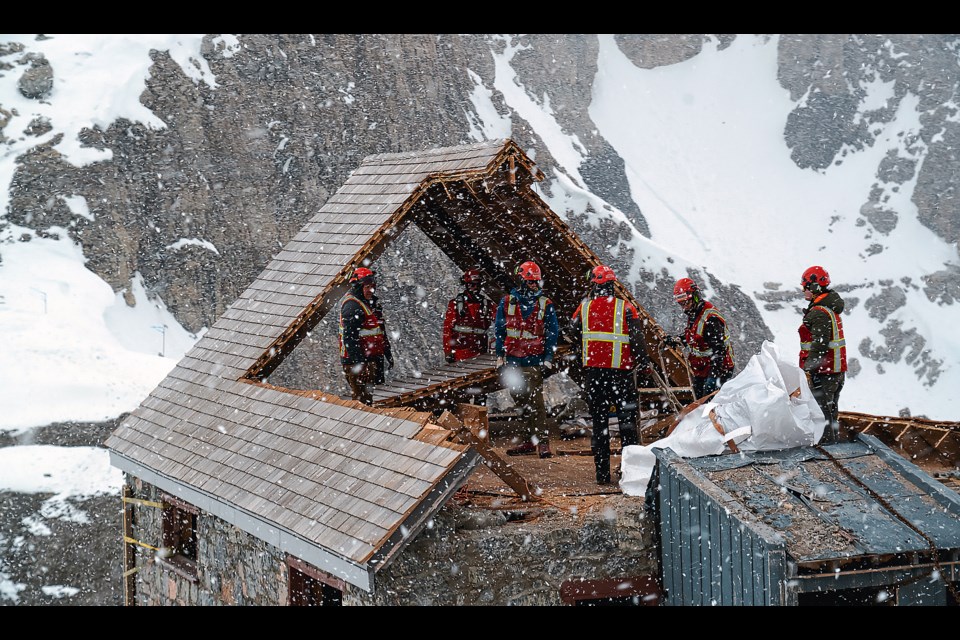LAKE LOUISE – Parks Canada has completed the dismantling and removal of the historic Abbot Pass Refuge Cabin, which had been planned since earlier this year.
Due to the instability of the slope, which was first noticed in 2016, the decision was made to remove the structure to ensure public safety. According to Parks Canada, if not for the slope stability decline, the structure could have stayed in place for several more decades but was ultimately removed June 30.
“This is a unique environment. It was affected very rapidly because of small changes in climate because it is in a vulnerable location,” said Francois Masse, superintendent for Lake Louise, Yoho and Kootenay field unit. “Throughout the parks system, we are seeing the impacts of climate change in many different ways.”
Built in 1922, the hut was the second highest permanently habitable structure in Canada. Named for Philip Stanley Abbot, the first recorded mountaineering fatality in North America, the structure was built by Swiss guides who worked for the Canadian Alpine Association (CAA).
Construction was done by bringing supplies from Lake Louise on horseback, manpower and winches. The CAA operated the hut for four decades until 1968 when Parks Canada took it over. In 1992, it was made a national historic site.
In 2018, Parks Canada invested $600,000 into rock stabilization work, which included rock anchors, but weather conditions prevented work from continuing in 2019. In 2020, pandemic restrictions prevented any work.
Slope erosion and glacial recession from climate change resulted in 114 cubic metres of material falling off the slope in 2021. After geotechnical surveys that same year, it was determined that there was no feasible option to conserve the existing structure.
The removal work began on June 17 and was completed by Tangiers Mountain Construction. The work presented challenges for the crews, who were working at a high altitude.
“The crew said they were feeling out of shape, it is very fatiguing,” said Sean Alexander, manager of safety and logistics. “A lot of machinery freezes up, engines don’t want to start because of the lack of air pressure, and you want to take more breaks than you would in the valley bottom.”
Through the work, the recognition and preservation of various parts of its history were at the forefront of Alexander’s mind, something he extended to his work crews.
“When we went up there initially, we went into the hut and had an hour discussion. We started the fire for the last time and had an intellectual discussion about what we were just about to do,” Alexander said.
Through the work to remove the hut, various remnants of the past were found, including names inscribed into the walls by the Swiss guides who built the hut. Alexander described finding objects dating from the earliest decades to the 1980s, as the structure was peeled away like an onion.
“There was an original walking stick that was under the floor, completely preserved and some very unique coins slipped in between pieces of wood that you wouldn’t have found if you hadn’t pulled that piece of wood off,” Alexander said. “They seemed like they were badges from other mountaineering groups. You would also see more modern stickers.”
For Keith Haberl, the director of marketing and communications for the Alpine Club of Canada, the loss of the hut was emotional.
“It is heartbreaking. It is one of the best-known huts in Canada, you can even argue North America,” Haberl said. “It has been associated with the Alpine Club of Canada for many years. For everyone in the club, guests who have stayed there, staff and a vast number of volunteers, it is something that everyone has a difficult time with.”
Parks Canada had looked at rebuilding the cabin elsewhere, but it was not feasible due to health and safety concerns and technical difficulties. The rocks that were part of the building were mostly dispersed in place, while some rocks, like the cornerstone, were brought back to preservation.
“They were rocks that were pulled from that place, and they went back to their natural environment,” said Masse. “We kept some key pieces that were used in the hut. These were kept with our partners to look at how they could be used for commemoration purposes.”
Moving forward, Parks Canada will now attempt to find a way to remember the role of the hut in Canadian history.
“We will start engaging. We are still putting together the process to engage with Indigenous groups and stakeholders to remember that place and its role in Canadian history,” Masse said. “We will be rolling that out in coming months, in order to determine the best way to remember that place.”




